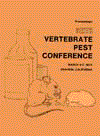Vertebrate Pest Conference Proceedings collection
Date of this Version
March 1974
Document Type
Article
Abstract
The new FEPCA legislation under which a l l of us now operate, changes the format and program of pesticide registration and use in the United States. One of the events immediately proceeding this law was the establishment of the United States Environmental Protection Agency, and the necessity for that new agency to develop guidelines and standards for the registration and use of pesticides. Early in 1973, a large number of persons associated with one or more areas of pesticides, and representing the academic world, consumers, and producing companies, assembled in Philadelphia to discuss with the American Society for Testing and Materials the possibility of developing a committee on pesticide standards. The purpose was to determine if there were interests enough to justify establishing a committee. During this three day meeting, conferees, almost 400 in number, representing all sections of the United States, heard speakers from the National Agricultural Chemical Association, EPA, ASTM Executive staff, and other groups speak to the needs for guidelines and standardizations. The main thrust of the discussion presented by EPA officials was that it was very difficult under administrative hearing procedures and rules governing federal agencies to develop standards and guidelines which might have the authenticity and scientific support to be representative of all aspects of American society in relationship to the use and registration of pesticides. They pointed out that ASTM has a long history of dealing with the difficult standards in a wide variety of situations, the steel industry, the chemical industry, plastics and more recently even medical transplants have been developed under the aegis of ASTM. The officials from ASTM pointed out that unless sufficient interest developed on the part of the conferees in the establishment of a committee, that ASTM could not undertake to do this itself since it is primarily a source of publication of standards and of the development of those standards and that it is supported by voluntary contributions, and dues of its members, both corporate and private, and the sale of its publications.

